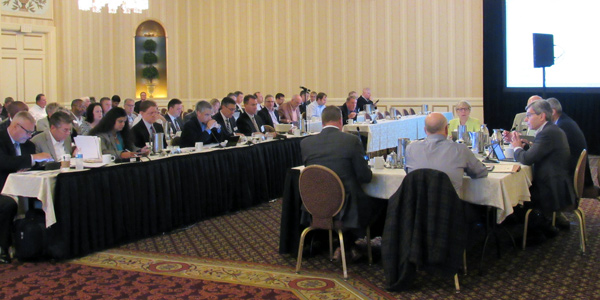By Amanda Durish Cook
ST. PAUL, Minn. — Three days shy of summer’s end, MISO’s staff and Independent Market Monitor convened to commend RTO operations personnel for a successful season.

Patton | © RTO Insider
Monitor David Patton said MISO’s real-time operations did a fine job of navigating summer’s Hurricane Harvey, Tropical Storm Cindy, the Aug. 21 solar eclipse and short bursts of high temperatures.
“We haven’t had any meteorites, but almost everything else under the sun,” Director Paul Bonavia joked during the summer operations presentation at the Sept. 19 meeting of the Markets Committee of the Board of Directors.
Vice President of System Operations Todd Ramey said MISO used its new hurricane action plan for the first time, maintaining communication and receiving updates from local operators near the storm. MISO held realistic hurricane simulations with MISO South operators during May and June, a first for the RTO, which ordinarily holds less-detailed hurricane drills.
“Hurricane Harvey proved to be mostly a rain and major flooding event. It did have some impact on transmission in the Eastern Texas area … but we maintained reliability throughout,” Ramey said.
Patton said despite occasional weather outbursts, the summer was “a little bit less eventful than past summers.” He called the 120.6-GW summer peak load on July 20 “very manageable” and “well below” the 125-GW forecast. A 6% rise in natural gas prices from last summer was offset by a 5% decrease in real-time energy prices due to mild temperatures and lower-than-expected average load.
The Monitor commended MISO’s ability to not declare any maximum generation events during the summer despite multiple operating reserve shortages from contingencies. He also praised MISO for producing more accurate day-ahead forecasts and more complete resource commitments when compared to last year. He told the board that while severe weather during June led to islanding in MISO, the RTO “was able to model the units in the islands and send appropriate prices during the events.”

Markets Committee of the Board of Directors meeting in progress | © RTO Insider
Patton also said MISO managed real-time congestion costs effectively during the summer, as they fell from $463.5 million last summer to $334.5 million this summer, in part because of moderate load.
Divergence on ELMP
But the Monitor differed with MISO on the efficacy of the RTO’s extended locational marginal price (ELMP) program, which this spring was expanded to include resources with one-hour start-up times. The program was previously available only to 10-minute fast-start resources.
The ELMP effort is not fulfilling its potential, resulting in only a 29-cents/MWh price increase in the real-time energy market since its expansion in spring, Patton said. The Monitor has long called on the RTO to expand ELMP to allow all generators with two-hour minimum run times to set prices.
MISO said the Monitor’s price-setting expansion would not be worth the expensive software change, but Patton said his change would have increased LMPs by $7/MWh, reflecting the true cost of using peaking units.
CEO John Bear said MISO only expected modest price impacts using ELMP, and the program has already exceeded the RTO’s expectations.
Ramey pointed out that MISO’s ELMP was judged a success in the recent U.S. Energy Department electricity markets report.
“I think FERC and others will be very interested in expanding this,” said Patton, who called ISO-NE’s price formation efforts “a Ferrari” in comparison.



